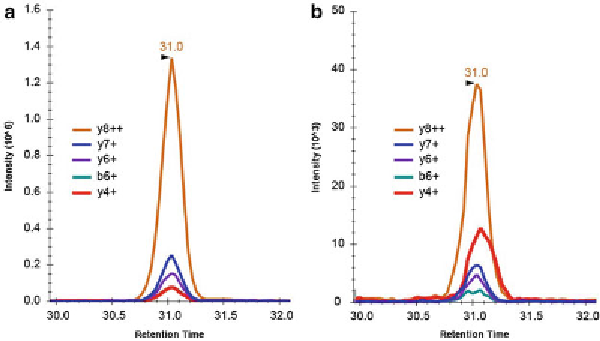Biology Reference
In-Depth Information
Fig.
2
Ion chromatogram of NH
2
-IPALDLLIK-COOH in SRM-MS on a triple quadrupole (Thermo TSQ Vantage).
(
a
) Shows the synthetically synthesized peptide with y8
++
transition as the most intense transition while y4
+
is one
of the least intense measured transitions. (
b
) Shows the endogenous measurement of the same peptide, although
in a complex cell lysate background. Note that the relative transition order is not conserved between the synthetic
less complex peptide and the complex whole cell lysate peptide mixture. Transition y8
++
is still the most intense
however y4
+
is now the second most intense transition. This gain in intensity is most likely due to interference, as
not only the relative intensity of a single transition changed, but also the peak shape and retention time
high complexity sample. For example, during SRM assay devel-
opment the sample complexity is relatively low (as described in
Subheadings 2.2.3 and 2.2.4) and the relative order of transi-
tions can be compared to the measurements of the same SRM
assay in a high complex sample, ideally using the same mass
spectrometer. Another way to detect interferences is to use a
fi nite number of stable isotope labeled reference peptides and
peptides originating from whole cell lysate and measure both
light
and
heavy
peptide pairs with the same SRM assay. As
shown in Fig.
2
there are discrepancies in the relative order of
transitions between the low and high complexity measure-
ments due to interference. Transitions with interference should
be omitted from quantifi cation and alternative transitions from
the peptide's SRM assay be measured.
Further omitted from the SRM transition list should be
very small fragment ions, as these carry little sequence informa-
tion, e.g., a b2 fragment ion is comprised of an NH
2
-terminus
and two amino acids, frequently resulting in a nondiscrimina-
tory
m/z
value. As a rule of thumb, the smallest fragment ion for
SRM transitions should be b4 and y4 [
24
,
28
].
3. Relative Retention Time
Crucial to scheduled SRM-MS are standardized retention times,
as the window of recording SRM transitions is limited to the time
when the peptide is expected to elute from the column. These
retention times can be predicted using in silico approaches, such

